+ データを開く
データを開く
- 基本情報
基本情報
| 登録情報 | データベース: PDB / ID: 7ptt | ||||||||||||
|---|---|---|---|---|---|---|---|---|---|---|---|---|---|
| タイトル | In-situ structure of hexameric S-layer protein | ||||||||||||
 要素 要素 | Cell surface glycoprotein | ||||||||||||
 キーワード キーワード | STRUCTURAL PROTEIN / S-layer csg | ||||||||||||
| 機能・相同性 | Surface glycoprotein signal peptide / Major cell surface glycoprotein / PGF-CTERM archaeal protein-sorting signal / PGF-CTERM motif / S-layer / cell wall organization / extracellular region / plasma membrane / Cell surface glycoprotein 機能・相同性情報 機能・相同性情報 | ||||||||||||
| 生物種 |  Haloferax volcanii DS2 (古細菌) Haloferax volcanii DS2 (古細菌) | ||||||||||||
| 手法 | 電子顕微鏡法 / サブトモグラム平均法 / クライオ電子顕微鏡法 / 解像度: 7.968 Å | ||||||||||||
 データ登録者 データ登録者 | von Kuegelgen, A. / Bharat, T.A.M. | ||||||||||||
| 資金援助 |  英国, 3件 英国, 3件
| ||||||||||||
 引用 引用 |  ジャーナル: Cell Rep / 年: 2021 ジャーナル: Cell Rep / 年: 2021タイトル: Complete atomic structure of a native archaeal cell surface. 著者: Andriko von Kügelgen / Vikram Alva / Tanmay A M Bharat /   要旨: Many prokaryotic cells are covered by an ordered, proteinaceous, sheet-like structure called a surface layer (S-layer). S-layer proteins (SLPs) are usually the highest copy number macromolecules in ...Many prokaryotic cells are covered by an ordered, proteinaceous, sheet-like structure called a surface layer (S-layer). S-layer proteins (SLPs) are usually the highest copy number macromolecules in prokaryotes, playing critical roles in cellular physiology such as blocking predators, scaffolding membranes, and facilitating environmental interactions. Using electron cryomicroscopy of two-dimensional sheets, we report the atomic structure of the S-layer from the archaeal model organism Haloferax volcanii. This S-layer consists of a hexagonal array of tightly interacting immunoglobulin-like domains, which are also found in SLPs across several classes of archaea. Cellular tomography reveal that the S-layer is nearly continuous on the cell surface, completed by pentameric defects in the hexagonal lattice. We further report the atomic structure of the SLP pentamer, which shows markedly different relative arrangements of SLP domains needed to complete the S-layer. Our structural data provide a framework for understanding cell surfaces of archaea at the atomic level. | ||||||||||||
| 履歴 |
|
- 構造の表示
構造の表示
| ムービー |
 ムービービューア ムービービューア |
|---|---|
| 構造ビューア | 分子:  Molmil Molmil Jmol/JSmol Jmol/JSmol |
- ダウンロードとリンク
ダウンロードとリンク
- ダウンロード
ダウンロード
| PDBx/mmCIF形式 |  7ptt.cif.gz 7ptt.cif.gz | 681.5 KB | 表示 |  PDBx/mmCIF形式 PDBx/mmCIF形式 |
|---|---|---|---|---|
| PDB形式 |  pdb7ptt.ent.gz pdb7ptt.ent.gz | 571.2 KB | 表示 |  PDB形式 PDB形式 |
| PDBx/mmJSON形式 |  7ptt.json.gz 7ptt.json.gz | ツリー表示 |  PDBx/mmJSON形式 PDBx/mmJSON形式 | |
| その他 |  その他のダウンロード その他のダウンロード |
-検証レポート
| 文書・要旨 |  7ptt_validation.pdf.gz 7ptt_validation.pdf.gz | 917.2 KB | 表示 |  wwPDB検証レポート wwPDB検証レポート |
|---|---|---|---|---|
| 文書・詳細版 |  7ptt_full_validation.pdf.gz 7ptt_full_validation.pdf.gz | 983.4 KB | 表示 | |
| XML形式データ |  7ptt_validation.xml.gz 7ptt_validation.xml.gz | 112.9 KB | 表示 | |
| CIF形式データ |  7ptt_validation.cif.gz 7ptt_validation.cif.gz | 168.9 KB | 表示 | |
| アーカイブディレクトリ |  https://data.pdbj.org/pub/pdb/validation_reports/pt/7ptt https://data.pdbj.org/pub/pdb/validation_reports/pt/7ptt ftp://data.pdbj.org/pub/pdb/validation_reports/pt/7ptt ftp://data.pdbj.org/pub/pdb/validation_reports/pt/7ptt | HTTPS FTP |
-関連構造データ
- リンク
リンク
- 集合体
集合体
| 登録構造単位 | 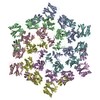
|
|---|---|
| 1 |
|
- 要素
要素
| #1: タンパク質 | 分子量: 81755.602 Da / 分子数: 6 / 由来タイプ: 天然 / 由来: (天然)  Haloferax volcanii DS2 (古細菌) / Plasmid details: Allers et al 2004 / 参照: UniProt: P25062 Haloferax volcanii DS2 (古細菌) / Plasmid details: Allers et al 2004 / 参照: UniProt: P25062 |
|---|
-実験情報
-実験
| 実験 | 手法: 電子顕微鏡法 |
|---|---|
| EM実験 | 試料の集合状態: CELL / 3次元再構成法: サブトモグラム平均法 |
- 試料調製
試料調製
| 構成要素 | 名称: In-situ structure of hexameric S-layer of Haloferax volcanii タイプ: ORGANELLE OR CELLULAR COMPONENT 詳細: In-situ structure of hexameric S-layer of Haloferax volcanii Entity ID: all / 由来: NATURAL | |||||||||||||||||||||||||||||||||||
|---|---|---|---|---|---|---|---|---|---|---|---|---|---|---|---|---|---|---|---|---|---|---|---|---|---|---|---|---|---|---|---|---|---|---|---|---|
| 分子量 | 実験値: NO | |||||||||||||||||||||||||||||||||||
| 由来(天然) | 生物種:  Haloferax volcanii DS2 (古細菌) / 細胞内の位置: Cell surface Haloferax volcanii DS2 (古細菌) / 細胞内の位置: Cell surface | |||||||||||||||||||||||||||||||||||
| 緩衝液 | pH: 7.5 / 詳細: 18 % (w/v) artificial sea water | |||||||||||||||||||||||||||||||||||
| 緩衝液成分 |
| |||||||||||||||||||||||||||||||||||
| 試料 | 包埋: NO / シャドウイング: NO / 染色: NO / 凍結: YES / 詳細: Haloferax volcanii vesicles | |||||||||||||||||||||||||||||||||||
| 試料支持 | 詳細: 20 seconds, 15 mA / グリッドの材料: COPPER/RHODIUM / グリッドのサイズ: 200 divisions/in. / グリッドのタイプ: Quantifoil R2/2 | |||||||||||||||||||||||||||||||||||
| 急速凍結 | 装置: FEI VITROBOT MARK IV / 凍結剤: ETHANE / 湿度: 100 % / 凍結前の試料温度: 283.15 K 詳細: Vitrobot options: Blot time 2.0 seconds, Blot force -15,1, Wait time 0 seconds, Drain time 0.5 seconds |
- 電子顕微鏡撮影
電子顕微鏡撮影
| 実験機器 |  モデル: Titan Krios / 画像提供: FEI Company |
|---|---|
| 顕微鏡 | モデル: FEI TITAN KRIOS / 詳細: SerialEM Hagen Scheme |
| 電子銃 | 電子線源:  FIELD EMISSION GUN / 加速電圧: 300 kV / 照射モード: FLOOD BEAM FIELD EMISSION GUN / 加速電圧: 300 kV / 照射モード: FLOOD BEAM |
| 電子レンズ | モード: BRIGHT FIELD / 倍率(公称値): 105000 X / 倍率(補正後): 105000 X / 最大 デフォーカス(公称値): 4000 nm / 最小 デフォーカス(公称値): 1000 nm / Calibrated defocus min: 1000 nm / 最大 デフォーカス(補正後): 4000 nm / Cs: 2.7 mm / C2レンズ絞り径: 50 µm / アライメント法: ZEMLIN TABLEAU |
| 試料ホルダ | 凍結剤: NITROGEN 試料ホルダーモデル: FEI TITAN KRIOS AUTOGRID HOLDER 最高温度: 70 K / 最低温度: 70 K |
| 撮影 | 平均露光時間: 1 sec. / 電子線照射量: 2.9 e/Å2 / 検出モード: COUNTING フィルム・検出器のモデル: GATAN K2 SUMMIT (4k x 4k) 撮影したグリッド数: 1 / 詳細: Dose symmetric tilt scheme (Hagen et al, JSB) |
| 電子光学装置 | エネルギーフィルター名称: GIF Quantum LS / 色収差補正装置: not used / エネルギーフィルタースリット幅: 20 eV / 球面収差補正装置: not used |
| 画像スキャン | 横: 3838 / 縦: 3710 |
- 解析
解析
| ソフトウェア | 名称: PHENIX / バージョン: 1.19_4092: / 分類: 精密化 | ||||||||||||||||||||||||||||||||||||||||||||||||||
|---|---|---|---|---|---|---|---|---|---|---|---|---|---|---|---|---|---|---|---|---|---|---|---|---|---|---|---|---|---|---|---|---|---|---|---|---|---|---|---|---|---|---|---|---|---|---|---|---|---|---|---|
| EMソフトウェア |
| ||||||||||||||||||||||||||||||||||||||||||||||||||
| CTF補正 | 詳細: RELION subtomogram averaging (Bharat & Scheres 2016) タイプ: PHASE FLIPPING AND AMPLITUDE CORRECTION | ||||||||||||||||||||||||||||||||||||||||||||||||||
| 粒子像の選択 | 選択した粒子像数: 1773652 詳細: Particles were initially picking using the Laplacian-of gaussian algorithm implemented in RELION3.0 (Zivanov et al., 2018). Particles were extracted in 8x down-sampled in 50x50 pixel boxes ...詳細: Particles were initially picking using the Laplacian-of gaussian algorithm implemented in RELION3.0 (Zivanov et al., 2018). Particles were extracted in 8x down-sampled in 50x50 pixel boxes and classified using reference-free 2D classification inside RELION3.0. | ||||||||||||||||||||||||||||||||||||||||||||||||||
| 対称性 | 点対称性: C6 (6回回転対称) | ||||||||||||||||||||||||||||||||||||||||||||||||||
| 3次元再構成 | 解像度: 7.968 Å / 解像度の算出法: FSC 0.143 CUT-OFF / 粒子像の数: 53063 / アルゴリズム: FOURIER SPACE / クラス平均像の数: 5 / 対称性のタイプ: POINT | ||||||||||||||||||||||||||||||||||||||||||||||||||
| EM volume selection | 手法: RELION / 詳細: RELION subtomogram averaging / Num. of tomograms: 127 / Num. of volumes extracted: 83713 / Reference model: Ab initio | ||||||||||||||||||||||||||||||||||||||||||||||||||
| 原子モデル構築 | プロトコル: RIGID BODY FIT / 空間: REAL / Target criteria: Best Fit 詳細: Rigid body fit inside coot of D1-D6 domains and real space refinement with restraints of the original model obtained by single particle analysis in PHENIX. |
 ムービー
ムービー コントローラー
コントローラー











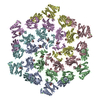
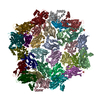
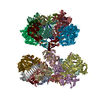
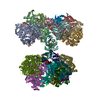
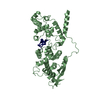

 PDBj
PDBj